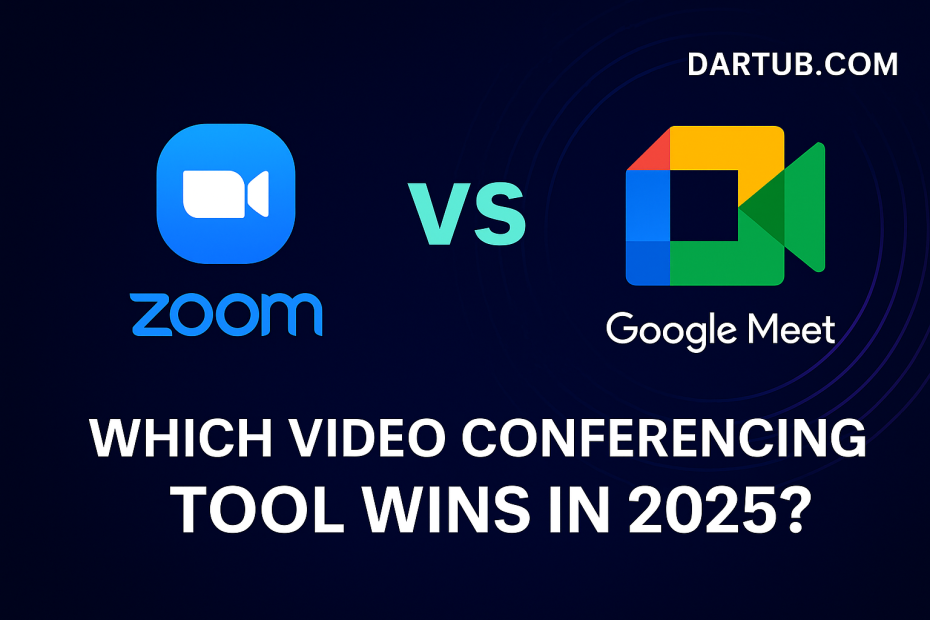Introduction
Remote work, hybrid teams, and global collaboration have made video conferencing software an essential tool in 2025. Whether it’s for daily meetings, webinars, online classes, or sales calls, businesses and professionals depend on reliable, high-quality video communication.
Two giants dominate the space: Zoom and Google Meet. Both platforms offer robust features and cater to individuals, teams, and enterprises. But which one should you choose in 2025?
This in-depth comparison breaks down everything — from usability and video quality to pricing, integrations, and unique strengths — to help you decide which video conferencing tool wins for your needs.
Overview of Each Platform
Zoom
Zoom remains a powerhouse in the video conferencing space. Known for its high-quality video/audio, reliability, and flexibility, Zoom is widely used across industries for meetings, virtual events, and collaboration.
Google Meet
Google Meet has evolved from a simple meeting app to a polished video platform integrated deeply with the Google Workspace ecosystem. It’s fast, browser-based, and perfect for Google-centric teams.
User Interface and Ease of Use
- Zoom: Feature-rich interface with dedicated desktop and mobile apps. Clean layout, but may feel overwhelming for new users due to the depth of features.
- Google Meet: Minimalist, browser-native interface. Seamless for those using Gmail, Calendar, or Google Docs. No software installation needed.
Winner: Google Meet for simplicity, Zoom for control.
Video & Audio Quality
- Zoom: Consistently delivers HD video and clear audio. Offers advanced noise cancellation and low-light video enhancement.
- Google Meet: Offers 720p video (1080p for some plans). Good quality, but may lag in large meetings or with weak connections.
Winner: Zoom for performance and flexibility.
Features Comparison (2025)
| Feature | Zoom | Google Meet |
|---|---|---|
| Max Participants | 1,000 (Enterprise) | 500 (Enterprise) |
| Recording | Local + Cloud | Cloud Only |
| Breakout Rooms | Yes | Yes (limited controls) |
| Virtual Backgrounds | Yes | Yes |
| Noise Cancellation | Advanced (AI-powered) | Basic |
| Whiteboarding | Integrated + 3rd party | Google Jamboard |
| Webinar Support | Yes (Zoom Webinars) | Limited via Live Stream |
| Third-Party Integrations | 1,000+ apps (Slack, Trello) | Deep Google Workspace focus |
| Transcription & Captions | Automated + Manual | Auto-captioning (real-time) |
| Multi-device Join | Yes | Yes |
Winner: Zoom for flexibility and advanced features. Google Meet excels in Google ecosystem use cases.
Security & Privacy
- Zoom: End-to-end encryption, meeting passwords, waiting rooms, and host controls. Enterprise-grade compliance.
- Google Meet: Encrypted in-transit, secure by design, seamless with Google Admin controls and policies.
Winner: Tie. Both are highly secure, especially in business environments.
Integrations and Ecosystem
- Zoom: Compatible with Microsoft Teams, Slack, Salesforce, HubSpot, Zapier, and many others.
- Google Meet: Deeply integrated into Google Workspace — Gmail, Docs, Calendar, Drive, Jamboard.
Winner: Depends on your stack. Zoom for diverse integrations, Google Meet for Google Workspace users.
Performance in Large Meetings
- Zoom: Handles large meetings smoothly. Hosts can assign co-hosts, manage participants, and monitor Q&A.
- Google Meet: Reliable in medium-size meetings. Struggles a bit beyond 250 attendees without premium plans.
Winner: Zoom for scalability.
Mobile Experience
- Zoom: Full-featured mobile apps with scheduling, screen sharing, reactions, and background effects.
- Google Meet: Lightweight mobile app with essential features, optimized for quick access.
Winner: Zoom for feature completeness.
Pricing (2025)
Zoom Pricing
- Free: 40-min limit, 100 participants
- Pro ($14.99/mo): Unlimited meetings, 30-hour limit
- Business ($19.99/mo): Up to 300 participants, SSO, cloud recording
- Enterprise: Custom pricing, up to 1,000 attendees, advanced analytics
Google Meet Pricing (via Google Workspace)
- Free: 60-minute limit, 100 participants
- Workspace Starter ($6/user/mo): 100 participants
- Workspace Standard ($12/user/mo): 150 participants, recording
- Workspace Plus ($18/user/mo): 500 participants, attendance tracking, noise cancellation
Winner: Google Meet for affordability in small teams. Zoom for enterprise-grade features.
Best for Different Use Cases
- Startups & Small Teams: Google Meet — lower cost, easy access
- Enterprises & Webinars: Zoom — scalability, flexibility
- Education: Zoom — breakout rooms, host control, integrations
- Internal Meetings: Google Meet — simplicity and calendar sync
Final Verdict
Zoom wins for power users, large-scale events, and teams needing deep control. Its feature set and scalability make it ideal for professional environments.
Google Meet shines for simplicity, budget-friendliness, and integration with Google tools. It’s perfect for Google Workspace users, small teams, and day-to-day meetings.
Ultimately, your winner depends on how you work. For organizations embedded in Google’s ecosystem, Google Meet is a no-brainer. For everyone else — especially those hosting events or needing fine-grained control — Zoom continues to lead in 2025.
